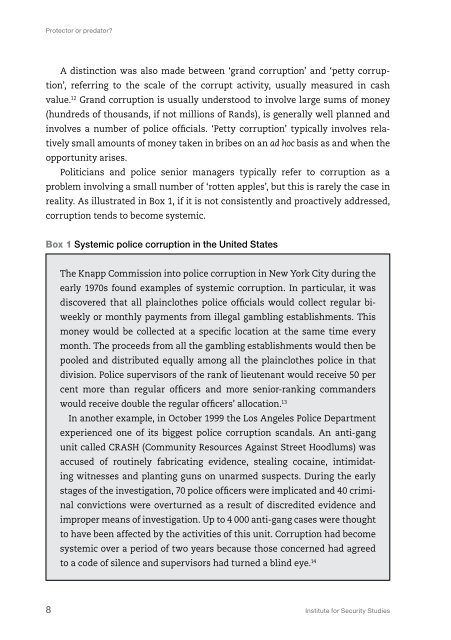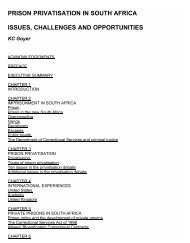Protector or predator? - Institute for Security Studies
Protector or predator? - Institute for Security Studies
Protector or predator? - Institute for Security Studies
Create successful ePaper yourself
Turn your PDF publications into a flip-book with our unique Google optimized e-Paper software.
<strong>Protect<strong>or</strong></strong> <strong>or</strong> predat<strong>or</strong>?<br />
A distinction was also made between ‘grand c<strong>or</strong>ruption’ and ‘petty c<strong>or</strong>ruption’,<br />
referring to the scale of the c<strong>or</strong>rupt activity, usually measured in cash<br />
value. 12 Grand c<strong>or</strong>ruption is usually understood to involve large sums of money<br />
(hundreds of thousands, if not millions of Rands), is generally well planned and<br />
involves a number of police officials. ‘Petty c<strong>or</strong>ruption’ typically involves relatively<br />
small amounts of money taken in bribes on an ad hoc basis as and when the<br />
opp<strong>or</strong>tunity arises.<br />
Politicians and police seni<strong>or</strong> managers typically refer to c<strong>or</strong>ruption as a<br />
problem involving a small number of ‘rotten apples’, but this is rarely the case in<br />
reality. As illustrated in Box 1, if it is not consistently and proactively addressed,<br />
c<strong>or</strong>ruption tends to become systemic.<br />
Box 1 Systemic police c<strong>or</strong>ruption in the United States<br />
The Knapp Commission into police c<strong>or</strong>ruption in New Y<strong>or</strong>k City during the<br />
early 1970s found examples of systemic c<strong>or</strong>ruption. In particular, it was<br />
discovered that all plainclothes police officials would collect regular biweekly<br />
<strong>or</strong> monthly payments from illegal gambling establishments. This<br />
money would be collected at a specific location at the same time every<br />
month. The proceeds from all the gambling establishments would then be<br />
pooled and distributed equally among all the plainclothes police in that<br />
division. Police supervis<strong>or</strong>s of the rank of lieutenant would receive 50 per<br />
cent m<strong>or</strong>e than regular officers and m<strong>or</strong>e seni<strong>or</strong>-ranking commanders<br />
would receive double the regular officers’ allocation. 13<br />
In another example, in October 1999 the Los Angeles Police Department<br />
experienced one of its biggest police c<strong>or</strong>ruption scandals. An anti-gang<br />
unit called CRASH (Community Resources Against Street Hoodlums) was<br />
accused of routinely fabricating evidence, stealing cocaine, intimidating<br />
witnesses and planting guns on unarmed suspects. During the early<br />
stages of the investigation, 70 police officers were implicated and 40 criminal<br />
convictions were overturned as a result of discredited evidence and<br />
improper means of investigation. Up to 4 000 anti-gang cases were thought<br />
to have been affected by the activities of this unit. C<strong>or</strong>ruption had become<br />
systemic over a period of two years because those concerned had agreed<br />
to a code of silence and supervis<strong>or</strong>s had turned a blind eye. 14<br />
8<br />
<strong>Institute</strong> f<strong>or</strong> <strong>Security</strong> <strong>Studies</strong>

















